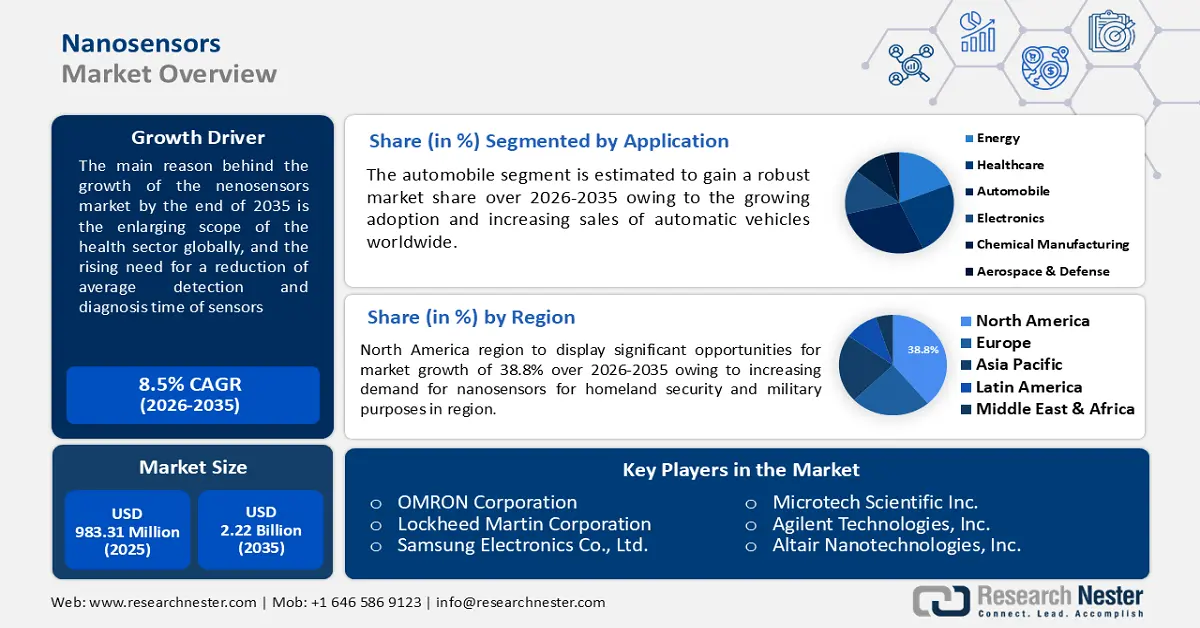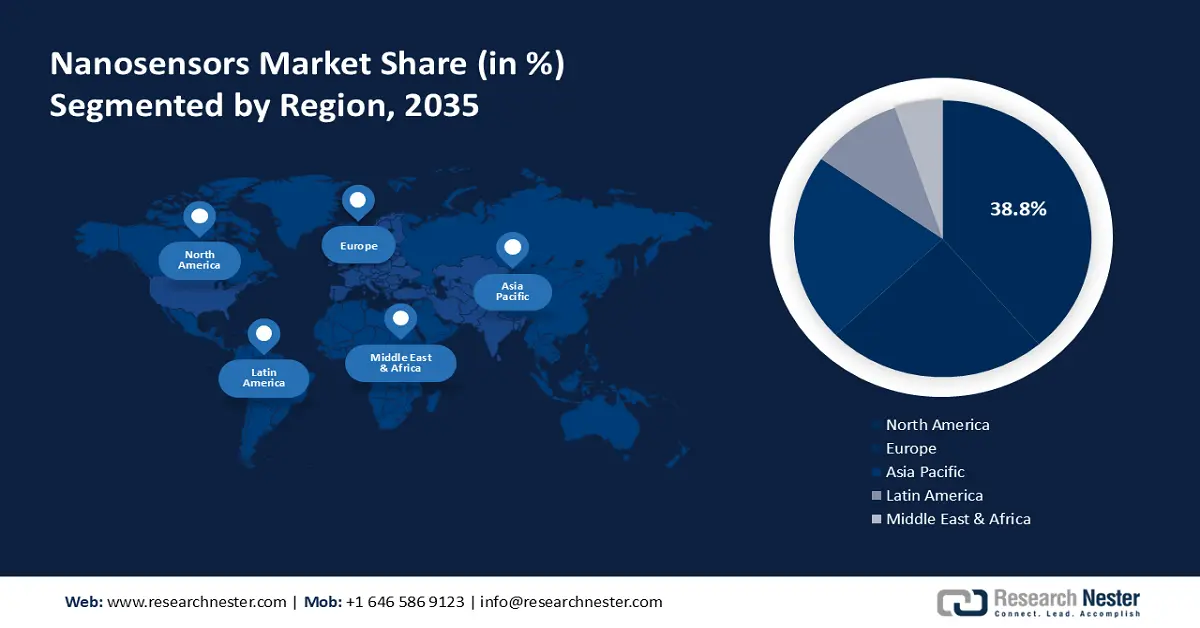纳米传感器市场展望:
2025年纳米传感器市场规模超过9.8331亿美元,预计到2035年将超过22.2亿美元,在预测期内(即2026-2035年)的复合年增长率将超过8.5%。预计到2026年,纳米传感器的行业规模将达到10.6亿美元。

市场的增长主要归因于全球医疗卫生领域范围的不断扩大,而对缩短传感器平均检测和诊断时间的需求日益增长,预计也将成为市场增长的驱动力。根据世界银行的数据,2019年全球医疗卫生总支出占GDP总量的9.83%,高于2018年的9.7%。此外,全球范围内微型化产品使用率的不断上升趋势预计将在预测期内为市场扩张提供巨大的机会。
纳米传感器是一种能够探测纳米颗粒的小型化学和生物传感器。鉴于其能够传递纳米颗粒信息的能力,纳米传感器行业正受到越来越多的关注。纳米传感器的尺寸通常在1纳米到100纳米之间。此外,纳米传感器在法医、癌症检测、军事和安全、航空航天等各个领域的应用日益广泛,对优质产品的需求不断增长,纳米传感器价格实惠,技术进步以及主要制造商不断开发和推出创新产品,预计将在预测期内推动全球纳米传感器市场的增长。例如,霍尼韦尔国际公司于2021年9月宣布推出最新的技术先进的机器人,旨在帮助仓库和配送中心实现手动托盘卸载流程的自动化,从而降低潜在伤害和劳动力短缺的操作风险。
关键 纳米传感器 市场洞察摘要:
区域亮点:
- 受军事需求和糖尿病患病率上升的推动,北美纳米传感器市场有望在 2035 年占据 38.8% 的市场份额。
细分市场洞察:
- 预计到 2035 年,汽车领域在纳米传感器市场中仍将保持最大份额,这得益于自动驾驶汽车的普及以及纳米技术带来的性能提升。
主要增长趋势:
- 全球皮肤癌发病率不断上升
- 全球电子设备行业快速扩张
主要挑战:
- 全球皮肤癌发病率不断上升
- 全球电子设备行业的快速扩张
主要参与者:霍尼韦尔国际公司、欧姆龙公司、洛克希德·马丁公司、三星电子有限公司、德州仪器公司、赛默飞世尔科技公司、Microtech Scientific Inc.、安捷伦科技公司、Altair Nanotechnologies, Inc.、Kleindiek Nanotechnik GmbH。
全球 纳米传感器 市场 预测与区域展望:
市场规模和增长预测:
- 2025年市场规模: 9.8331亿美元
- 2026年市场规模: 10.6亿美元
- 预计市场规模:到 2035 年将达到 22.2 亿美元
- 增长预测:复合年增长率8.5%(2026-2035)
主要区域动态:
- 最大的地区:北美(到 2035 年占比 38.8%)
- 增长最快的地区:北美
- 主要国家:美国、中国、日本、德国、韩国
- 新兴国家:中国、印度、日本、韩国、巴西
Last updated on : 8 September, 2025
纳米传感器市场的增长动力和挑战:
增长动力
- 全球皮肤癌发病率不断上升——例如,在美国,每天有近9,400人患皮肤癌,每小时有超过2人死于皮肤癌。纳米医学应用可用于治疗皮肤癌。通过这种方式,药物和其他药物治疗可以有效地作用于特定的肿瘤区域和靶细胞,且副作用最小。纳米医学已用于开发一种检测血液中癌细胞的新方法,称为纳米耀斑(Nano Flares)。因此,纳米传感器在治疗皮肤癌的药物中的应用日益广泛,预计将在预测期内推动市场增长。
- 全球电子设备行业的快速扩张——据观察,2020 年全球电子设备市场规模达到 2.8 万亿美元。印度在电子设备行业的份额从 2012 年的 1.2% 增长到 2019 年的 3.5%。
- 医疗机构实验室检测数量激增——根据美国疾病控制与预防中心的数据,每年进行近140亿次实验室检测。这些检测在70%的医疗决策中发挥着重要作用。
- 研发活动支出不断增加——根据世界银行的数据,2020年全球研发支出占GDP总量的2.63%,高于2018年的2.2%。
- 个人可支配收入增加——根据经济分析局的数据,2022 年 7 月个人可支配收入增长至 376 亿美元(0.2%),而个人消费支出增长了 470 亿美元(0.2%)。
挑战
- 高科技纳米传感器的高成本——由于缺乏对纳米材料健康影响的了解以及某些新鲜食材的高成本,纳米传感器的商业成功已经受到严重影响。根据最新数据,预计年产量可达100万个,每个成本低于5.2美元,并进行客户演示。
- 纳米设备在不利条件下部署的问题
- 产品开发的复杂性
纳米传感器市场规模和预测:
| 报告属性 | 详细信息 |
|---|---|
|
基准年 |
2025 |
|
预测期 |
2026-2035 |
|
复合年增长率 |
8.5% |
|
基准年市场规模(2025年) |
9.8331亿美元 |
|
预测年度市场规模(2035年) |
22.2亿美元 |
|
区域范围 |
|
纳米传感器市场细分:
应用细分分析
全球纳米传感器市场按应用领域细分,并根据其需求和供应情况进行分析,涵盖电子、化工制造、航空航天与国防、能源、医疗保健和汽车等领域。在这些细分市场中,由于全球自动驾驶汽车的普及率不断提高且销量不断增长,预计汽车市场将占据全球纳米传感器市场的最大份额。例如,2018年特斯拉汽车在美国的销量接近19.55万辆,较2017年的4.7万辆增长了275%。应用于汽车的纳米技术提高了安全性,并提升了用户体验。此外,不断增长的购买力和对奢华生活方式的追求预计将在预测期内促进该细分市场的增长。
我们对全球纳米传感器市场的深入分析包括以下部分:
按类型 |
|
按应用 |
|

Vishnu Nair
全球业务发展主管根据您的需求定制此报告 — 联系我们的顾问,获取个性化见解和选项。
纳米传感器市场区域分析:
北美市场洞察
预计到 2035 年,北美地区的市场份额将超过 38.8%,这主要得益于军事需求和糖尿病患病率的上升。此外,医疗支出的激增和主要市场参与者的加入也有望推动该地区市场的增长。根据经济合作与发展组织 (OECD) 的数据,美国在 2019 年的医疗支出最高,人均医疗支出估计为 11,072 美元。此外,该地区糖尿病患病率的上升预计将推动有效疾病检测技术的需求增长。这也被认为是未来几年北美市场增长的原因。

纳米传感器市场参与者:
- 霍尼韦尔国际公司
- 公司概况
- 商业策略
- 主要产品
- 财务表现
- 关键绩效指标
- 风险分析
- 近期发展
- 区域影响力
- SWOT分析
- 欧姆龙公司
- 洛克希德·马丁公司
- 三星电子有限公司
- 德州仪器公司
- 赛默飞世尔科技公司
- 微技术科学公司
- 安捷伦科技公司
- Altair纳米技术公司
- 克莱因迪克纳米技术有限公司
最新发展
霍尼韦尔国际公司宣布与领先的医疗保健提供商合作,提供传感器和先进的数字技术,旨在改善患者的治疗效果。
欧姆龙公司今日宣布,欧姆龙公司推出的B5WC颜色传感器,可检测全球范围内细微的颜色变化,并于2022年11月1日正式面向工业应用。该传感器利用颜色追踪油液状态,持续追踪工业技术中液压机械的油液劣化情况。
- Report ID: 3083
- Published Date: Sep 08, 2025
- Report Format: PDF, PPT
- 获取特定细分市场/地区的详细见解
- 咨询适用于您行业的报告定制服务
- 了解我们为初创企业提供的特价方案
- 请求报告关键发现的演示
- 了解报告的预测方法
- 咨询购买后的支持与更新
- 了解公司层级情报的附加内容
有特定数据需求或预算限制?
常见问题 (FAQ)
纳米传感器 市场报告范围
See how top U.S. companies are managing market uncertainty — get your free sample with trends, challenges, macroeconomic factors, charts, forecasts, and more.
版权所有 © 2025 Research Nester。保留所有权利。

 购买前咨询
购买前咨询


 Afghanistan (+93)
Afghanistan (+93)
 Åland Islands (+358)
Åland Islands (+358)
 Albania (+355)
Albania (+355)
 Algeria (+213)
Algeria (+213)
 American Samoa (+1684)
American Samoa (+1684)
 Andorra (+376)
Andorra (+376)
 Angola (+244)
Angola (+244)
 Anguilla (+1264)
Anguilla (+1264)
 Antarctica (+672)
Antarctica (+672)
 Antigua and Barbuda (+1268)
Antigua and Barbuda (+1268)
 Argentina (+54)
Argentina (+54)
 Armenia (+374)
Armenia (+374)
 Aruba (+297)
Aruba (+297)
 Australia (+61)
Australia (+61)
 Austria (+43)
Austria (+43)
 Azerbaijan (+994)
Azerbaijan (+994)
 Bahamas (+1242)
Bahamas (+1242)
 Bahrain (+973)
Bahrain (+973)
 Bangladesh (+880)
Bangladesh (+880)
 Barbados (+1246)
Barbados (+1246)
 Belarus (+375)
Belarus (+375)
 Belgium (+32)
Belgium (+32)
 Belize (+501)
Belize (+501)
 Benin (+229)
Benin (+229)
 Bermuda (+1441)
Bermuda (+1441)
 Bhutan (+975)
Bhutan (+975)
 Bolivia (+591)
Bolivia (+591)
 Bosnia and Herzegovina (+387)
Bosnia and Herzegovina (+387)
 Botswana (+267)
Botswana (+267)
 Bouvet Island (+)
Bouvet Island (+)
 Brazil (+55)
Brazil (+55)
 British Indian Ocean Territory (+246)
British Indian Ocean Territory (+246)
 British Virgin Islands (+1284)
British Virgin Islands (+1284)
 Brunei (+673)
Brunei (+673)
 Bulgaria (+359)
Bulgaria (+359)
 Burkina Faso (+226)
Burkina Faso (+226)
 Burundi (+257)
Burundi (+257)
 Cambodia (+855)
Cambodia (+855)
 Cameroon (+237)
Cameroon (+237)
 Canada (+1)
Canada (+1)
 Cape Verde (+238)
Cape Verde (+238)
 Cayman Islands (+1345)
Cayman Islands (+1345)
 Central African Republic (+236)
Central African Republic (+236)
 Chad (+235)
Chad (+235)
 Chile (+56)
Chile (+56)
 China (+86)
China (+86)
 Christmas Island (+61)
Christmas Island (+61)
 Cocos (Keeling) Islands (+61)
Cocos (Keeling) Islands (+61)
 Colombia (+57)
Colombia (+57)
 Comoros (+269)
Comoros (+269)
 Cook Islands (+682)
Cook Islands (+682)
 Costa Rica (+506)
Costa Rica (+506)
 Croatia (+385)
Croatia (+385)
 Cuba (+53)
Cuba (+53)
 Curaçao (+599)
Curaçao (+599)
 Cyprus (+357)
Cyprus (+357)
 Czechia (+420)
Czechia (+420)
 Democratic Republic of the Congo (+243)
Democratic Republic of the Congo (+243)
 Denmark (+45)
Denmark (+45)
 Djibouti (+253)
Djibouti (+253)
 Dominica (+1767)
Dominica (+1767)
 Dominican Republic (+1809)
Dominican Republic (+1809)
 Timor-Leste (+670)
Timor-Leste (+670)
 Ecuador (+593)
Ecuador (+593)
 Egypt (+20)
Egypt (+20)
 El Salvador (+503)
El Salvador (+503)
 Equatorial Guinea (+240)
Equatorial Guinea (+240)
 Eritrea (+291)
Eritrea (+291)
 Estonia (+372)
Estonia (+372)
 Ethiopia (+251)
Ethiopia (+251)
 Falkland Islands (+500)
Falkland Islands (+500)
 Faroe Islands (+298)
Faroe Islands (+298)
 Fiji (+679)
Fiji (+679)
 Finland (+358)
Finland (+358)
 France (+33)
France (+33)
 Gabon (+241)
Gabon (+241)
 Gambia (+220)
Gambia (+220)
 Georgia (+995)
Georgia (+995)
 Germany (+49)
Germany (+49)
 Ghana (+233)
Ghana (+233)
 Gibraltar (+350)
Gibraltar (+350)
 Greece (+30)
Greece (+30)
 Greenland (+299)
Greenland (+299)
 Grenada (+1473)
Grenada (+1473)
 Guadeloupe (+590)
Guadeloupe (+590)
 Guam (+1671)
Guam (+1671)
 Guatemala (+502)
Guatemala (+502)
 Guinea (+224)
Guinea (+224)
 Guinea-Bissau (+245)
Guinea-Bissau (+245)
 Guyana (+592)
Guyana (+592)
 Haiti (+509)
Haiti (+509)
 Honduras (+504)
Honduras (+504)
 Hong Kong (+852)
Hong Kong (+852)
 Hungary (+36)
Hungary (+36)
 Iceland (+354)
Iceland (+354)
 India (+91)
India (+91)
 Indonesia (+62)
Indonesia (+62)
 Iran (+98)
Iran (+98)
 Iraq (+964)
Iraq (+964)
 Ireland (+353)
Ireland (+353)
 Isle of Man (+44)
Isle of Man (+44)
 Israel (+972)
Israel (+972)
 Italy (+39)
Italy (+39)
 Jamaica (+1876)
Jamaica (+1876)
 Japan (+81)
Japan (+81)
 Jersey (+44)
Jersey (+44)
 Jordan (+962)
Jordan (+962)
 Kazakhstan (+7)
Kazakhstan (+7)
 Kenya (+254)
Kenya (+254)
 Kiribati (+686)
Kiribati (+686)
 Kuwait (+965)
Kuwait (+965)
 Kyrgyzstan (+996)
Kyrgyzstan (+996)
 Laos (+856)
Laos (+856)
 Latvia (+371)
Latvia (+371)
 Lebanon (+961)
Lebanon (+961)
 Lesotho (+266)
Lesotho (+266)
 Liberia (+231)
Liberia (+231)
 Libya (+218)
Libya (+218)
 Liechtenstein (+423)
Liechtenstein (+423)
 Lithuania (+370)
Lithuania (+370)
 Luxembourg (+352)
Luxembourg (+352)
 Macao (+853)
Macao (+853)
 Madagascar (+261)
Madagascar (+261)
 Malawi (+265)
Malawi (+265)
 Malaysia (+60)
Malaysia (+60)
 Maldives (+960)
Maldives (+960)
 Mali (+223)
Mali (+223)
 Malta (+356)
Malta (+356)
 Marshall Islands (+692)
Marshall Islands (+692)
 Mauritania (+222)
Mauritania (+222)
 Mauritius (+230)
Mauritius (+230)
 Mayotte (+262)
Mayotte (+262)
 Mexico (+52)
Mexico (+52)
 Micronesia (+691)
Micronesia (+691)
 Moldova (+373)
Moldova (+373)
 Monaco (+377)
Monaco (+377)
 Mongolia (+976)
Mongolia (+976)
 Montenegro (+382)
Montenegro (+382)
 Montserrat (+1664)
Montserrat (+1664)
 Morocco (+212)
Morocco (+212)
 Mozambique (+258)
Mozambique (+258)
 Myanmar (+95)
Myanmar (+95)
 Namibia (+264)
Namibia (+264)
 Nauru (+674)
Nauru (+674)
 Nepal (+977)
Nepal (+977)
 Netherlands (+31)
Netherlands (+31)
 New Caledonia (+687)
New Caledonia (+687)
 New Zealand (+64)
New Zealand (+64)
 Nicaragua (+505)
Nicaragua (+505)
 Niger (+227)
Niger (+227)
 Nigeria (+234)
Nigeria (+234)
 Niue (+683)
Niue (+683)
 Norfolk Island (+672)
Norfolk Island (+672)
 North Korea (+850)
North Korea (+850)
 Northern Mariana Islands (+1670)
Northern Mariana Islands (+1670)
 Norway (+47)
Norway (+47)
 Oman (+968)
Oman (+968)
 Pakistan (+92)
Pakistan (+92)
 Palau (+680)
Palau (+680)
 Palestine (+970)
Palestine (+970)
 Panama (+507)
Panama (+507)
 Papua New Guinea (+675)
Papua New Guinea (+675)
 Paraguay (+595)
Paraguay (+595)
 Peru (+51)
Peru (+51)
 Philippines (+63)
Philippines (+63)
 Poland (+48)
Poland (+48)
 Portugal (+351)
Portugal (+351)
 Puerto Rico (+1787)
Puerto Rico (+1787)
 Qatar (+974)
Qatar (+974)
 Romania (+40)
Romania (+40)
 Russia (+7)
Russia (+7)
 Rwanda (+250)
Rwanda (+250)
 Saint Barthélemy (+590)
Saint Barthélemy (+590)
 Saint Helena, Ascension and Tristan da Cunha (+290)
Saint Helena, Ascension and Tristan da Cunha (+290)
 Saint Kitts and Nevis (+1869)
Saint Kitts and Nevis (+1869)
 Saint Lucia (+1758)
Saint Lucia (+1758)
 Saint Martin (French part) (+590)
Saint Martin (French part) (+590)
 Saint Pierre and Miquelon (+508)
Saint Pierre and Miquelon (+508)
 Saint Vincent and the Grenadines (+1784)
Saint Vincent and the Grenadines (+1784)
 Samoa (+685)
Samoa (+685)
 San Marino (+378)
San Marino (+378)
 Sao Tome and Principe (+239)
Sao Tome and Principe (+239)
 Saudi Arabia (+966)
Saudi Arabia (+966)
 Senegal (+221)
Senegal (+221)
 Serbia (+381)
Serbia (+381)
 Seychelles (+248)
Seychelles (+248)
 Sierra Leone (+232)
Sierra Leone (+232)
 Singapore (+65)
Singapore (+65)
 Sint Maarten (Dutch part) (+1721)
Sint Maarten (Dutch part) (+1721)
 Slovakia (+421)
Slovakia (+421)
 Slovenia (+386)
Slovenia (+386)
 Solomon Islands (+677)
Solomon Islands (+677)
 Somalia (+252)
Somalia (+252)
 South Africa (+27)
South Africa (+27)
 South Georgia and the South Sandwich Islands (+0)
South Georgia and the South Sandwich Islands (+0)
 South Korea (+82)
South Korea (+82)
 South Sudan (+211)
South Sudan (+211)
 Spain (+34)
Spain (+34)
 Sri Lanka (+94)
Sri Lanka (+94)
 Sudan (+249)
Sudan (+249)
 Suriname (+597)
Suriname (+597)
 Svalbard and Jan Mayen (+47)
Svalbard and Jan Mayen (+47)
 Eswatini (+268)
Eswatini (+268)
 Sweden (+46)
Sweden (+46)
 Switzerland (+41)
Switzerland (+41)
 Syria (+963)
Syria (+963)
 Taiwan (+886)
Taiwan (+886)
 Tajikistan (+992)
Tajikistan (+992)
 Tanzania (+255)
Tanzania (+255)
 Thailand (+66)
Thailand (+66)
 Togo (+228)
Togo (+228)
 Tokelau (+690)
Tokelau (+690)
 Tonga (+676)
Tonga (+676)
 Trinidad and Tobago (+1868)
Trinidad and Tobago (+1868)
 Tunisia (+216)
Tunisia (+216)
 Turkey (+90)
Turkey (+90)
 Turkmenistan (+993)
Turkmenistan (+993)
 Turks and Caicos Islands (+1649)
Turks and Caicos Islands (+1649)
 Tuvalu (+688)
Tuvalu (+688)
 Uganda (+256)
Uganda (+256)
 Ukraine (+380)
Ukraine (+380)
 United Arab Emirates (+971)
United Arab Emirates (+971)
 United Kingdom (+44)
United Kingdom (+44)
 Uruguay (+598)
Uruguay (+598)
 Uzbekistan (+998)
Uzbekistan (+998)
 Vanuatu (+678)
Vanuatu (+678)
 Vatican City (+39)
Vatican City (+39)
 Venezuela (Bolivarian Republic of) (+58)
Venezuela (Bolivarian Republic of) (+58)
 Vietnam (+84)
Vietnam (+84)
 Wallis and Futuna (+681)
Wallis and Futuna (+681)
 Western Sahara (+212)
Western Sahara (+212)
 Yemen (+967)
Yemen (+967)
 Zambia (+260)
Zambia (+260)
 Zimbabwe (+263)
Zimbabwe (+263)
